Assessing Moral Judgements in Veterinary Students: An Exploratory Mixed-Methods Study from Germany
Abstract
:Simple Summary
Abstract
1. Introduction
The Veterinary Ethics Curriculum in Hannover since 2015
- identify stakeholders of different conflicts in veterinary practice;
- show awareness of the complexity of ethical conflicts;
- think about obtaining all necessary information in acute situations; and
- come to a well-founded decision in the given case scenarios.
2. Materials and Methods
- Which stakeholders are involved in the presented conflict?
- To what extent is there an ethical conflict?
- Do you need further information before making a decision in this case?
- How would you decide if you were the veterinarian?
- -
- O1: Autonomy of the Patient Owner (PO): Taking into account and, in case of doubt, prioritising the autonomy of the PO over other aspects.
- -
- O2: Financial Problems of the PO: taking into account economic constraints of the PO and considering them as substantial for decision-making.
- -
- O3: Quality of Life (QOL) of the Patient: Considering the patient’s quality of life and putting it above other factors.
- -
- O4: Own Ethical Attitude: Consistently representing one’s own position and not moving away from it when begged by patient owners.
- -
- O5: Own Financial Situation: Accepting own economic losses if a situation calls for it, especially if the owner can/does not want to pay.
- -
- O6: Communication: Striving for communicative solutions or emphasising the necessity of a communication process.
- -
- O7: (Animal Welfare) Law: Invoking the legal framework/referring to animal welfare law as a basis or reason for a decision.
- -
- O8: Avoiding a Decision: Postponing or avoiding making a decision.
3. Results
3.1. General Free Text Results
- -
- A conception of veterinarians as service providers:
“On the other hand, the farmer authorises the veterinarian with a certain examination and treatment by presenting a patient; the veterinarian cannot treat without having been authorised to do so.” (WE Group, Farm Scenario, question “to what extent is there an ethical conflict?”).
- -
- A conception of veterinarians as business owners and, therefore, being focussed on securing their income:
“ […] economic interest, i.e., possibly losing the customer if one contradicts him.” (NE Group, Farm Scenario, “to what extent is there an ethical conflict?”),
“If no one can or wants to pay for the treatment, you can’t permanently be charitable yourself” (NE Group, Companion Animal Scenario, “How would you decide?”).
- -
- A conception of veterinarians as “the animals’ advocates” and, thus, putting life and welfare of the patient above the client’s or the veterinarian’s economic preferences:
“I see this as a general duty of a veterinarian to protect the animals, even on a farm you depend on economically.” (WE Group, Farm Animal Scenario, “How would you decide?”),
“I would operate on the guinea pig myself as far as my finances allow and then look for a new home within the practice/among other patient owners.” (NE Group, Companion Animal Scenario, “How would you decide?”).
- -
- The widespread strategy to convince the client that the medically indicated decision is also the economically most advantageous one:
“Try to convince the farmer that healthy animals can also perform better.” (NE Group, Farm Animal Scenario, “How would you decide?”),
“ […] in cows, lung diseases and reduced well-being affect milk yield, etc., and one should aim for a healthy herd in the long term. Thus, veterinary costs should be seen more as investments than as costs.” (WE Group, Farm Animal Scenario, “How would you decide?”),
“Reference to profitability. To miss a tournament, now, but to be able to win many more later will certainly generate more money” (NE Group, Jumping Horse Scenario, “How would you decide?).
3.2. Scenario-Specific Free-Text Results
3.2.1. Farm Scenario
“On the one hand, the veterinarian cannot leave the other cows untreated from an ethical point of view, as these animals also have a right to treatment. On the other hand, it cannot be expected that the farmer runs into financial difficulties because he cannot afford the treatment and possibly faces such financial problems that his existence is endangered in the process.” (WE Group).
“ […] The veterinarian is obliged to alleviate or remedy pain, suffering and damage if possible. Everyone who keeps an animal is obliged to care for it according to its needs and to prevent pain, suffering and damage. Purely economic reasons cannot be considered a reasonable cause under the Animal Welfare Act. Veterinary Professional Code, Animal Welfare Act <-> economic interest. On the other hand, the farmer commissions the veterinarian to perform a certain examination and treatment by presenting a patient the veterinarian cannot treat without having been authorised to do so.” (WE Group).
“If no compliance can be achieved at all, the veterinarian should discontinue his veterinary care on this farm and, depending on the severity of the problem, the local veterinary office must be informed.”
“The farmer is also important, and you can’t ask him to ruin himself financially. However, animal welfare is also just as important” (WE Group).
“The veterinarian has the problem that the farmer does not want to have the sick animals treated by her for financial reasons, although it would be appropriate.” (NE Group).
“For the moment, let the matter settle. If necessary, inform the farmer of possible causes and explain why an early examination to detect and treat any disease that may be present and may even be spreading in the herd would be economically better than waiting until it is unavoidable. If the farmer cannot be convinced to have the animals examined immediately, another look should be taken at the follow-up examination of the cow that was actually treated. You can also ask the farmer to get back to you should the cough not subside in a few days, the symptoms get worse or more animals are affected.” (WE Group).
3.2.2. Companion Animal Scenario
“The guinea pig’s illness would be treatable but costs the pet owner too much money. This presents the conflict between animal life and costs.” (WE Group).
“There is the possibility of treatment. Therefore, euthanasia is not necessary and is carried out in this case for financial reasons.” (WE Group).
“I would definitely not euthanise the animal that is treatable.” (NE Group).
“or the animal would die miserably at home, even if I give an analgesic temporarily, that would not be a nice solution” (WE Group).
“The client will probably find another colleague who will euthanise the animal as she wants. I don’t think it’s right to euthanise the animal only because someone else will do it. You should set an example and stand by your convictions. If everyone did that, such owners would have fewer chances.” (WE Group).
“If the opinion does not change and no further rehoming is possible, euthanise to avoid further suffering. An animal will probably suffer more from chronic pain than from the dying process.” (NE Group, “how would you decide?”).
“Law: You may not euthanise an animal without reasonable cause.” (NE Group, “to what extent is there an ethical conflict?”).“I would point out to the mother that she is responsible for the health of the animal in accordance with the Animal Welfare Act and that you can’t just put an animal down like that.” (NE Group, “how would you decide?”).
3.2.3. Jumping Horse Scenario
“What exactly is the lameness? The extent/degree of lameness is decisive for the type and success of therapy” (WE Group, “Further Information?”).
“In this case, I would not perform any treatment at the request of the owner, which could lead to long-term harm to the animal. With the expression “the horse has a good life insurance” he shows that he does not care about the welfare of the animal and profit is important to him. I would not support this in any case. In addition, I could imagine that with such a “treatment error”, my license to practise medicine would be at risk. Finally, I would try to explain this to the owner again and bring him to his senses. I see the attitude of the owner as problematic: He will probably just call the next veterinarian and ask him to inject the analgesic…” (WE Group, “How would you decide?”).
3.3. Results Likert Scales
4. Discussion
5. Conclusions
Supplementary Materials
Author Contributions
Funding
Institutional Review Board Statement
Informed Consent Statement
Data Availability Statement
Acknowledgments
Conflicts of Interest
References
- Voigt, L.C. Untersuchungen zur Euthanasieentscheidung von Tierbesitzern* Hinsichtlich Entscheidungsfindung, Umgang und Trauerbewältigung. Doctoral Thesis, Stiftung Tierärztliche Hochschule Hannover, Hannover, Germany, 2017. [Google Scholar]
- Batchelor, C.E.; McKeegan, D.E. Survey of the frequency and perceived stressfulness of ethical dilemmas encountered in UK veterinary practice. Vet. Rec. 2012, 170, 19. [Google Scholar] [CrossRef] [Green Version]
- Dürnberger, C. I Would like to, but I can’t. An Online Survey on the Moral Challenges of German Farm Veterinarians. J. Agric. Environ. Ethics 2020, 33, 447–460. [Google Scholar] [CrossRef]
- Kipperman, B.; Morris, P.; Rollin, B. Ethical dilemmas encountered by small animal veterinarians: Characterisation, responses, consequences and beliefs regarding euthanasia. Vet. Rec. 2018, 182, 548. [Google Scholar] [CrossRef]
- Moses, L.; Malowney, M.J.; Wesley Boyd, J. Ethical conflict and moral distress in veterinary practice: A survey of North American veterinarians. J. Vet. Intern. Med. 2018, 32, 2115–2122. [Google Scholar] [CrossRef] [PubMed]
- Morton, D.; Magalhães Sant’Ana, M.; Ohl, F.; Ilieski, V.; Simonin, D.; Keeling, L.; Wöhr, A.-C.; Zemljic, B.; Neuhaus, D.; Pesie, S.; et al. FVE, AWARE & EAEVE Report on European Veterinary Education in Animal Welfare Science, Ethics and Law; Federation of Veterinarians of Europe: Vienna, Austria, 2013. [Google Scholar]
- European Coordinating Committee on Veterinary Training (ECCVT). List of Subjects and Day One Competences (As Approved by ECCVT on 17 January 2019); ECCVT: Brussels, Belgium, 2019. [Google Scholar]
- De Briyne, N.; Vidovic, J.; Morton, D.B.; Magalhaes-Sant’Ana, M. Evolution of the Teaching of Animal Welfare Science, Ethics and Law in European Veterinary Schools (2012–2019). Animals 2020, 10, 1238. [Google Scholar] [CrossRef]
- Dawkins, M.S. A user’s guide to animal welfare science. Trends Ecol. Evol. 2006, 21, 77–82. [Google Scholar] [CrossRef] [PubMed]
- Fraser, D. Animal ethics and animal welfare science: Bridging the two cultures. Appl. Anim. Behav. Sci. 1999, 65, 171–189. [Google Scholar] [CrossRef] [Green Version]
- Magalhães, S.A.M. Ethics teaching in European veterinary schools: A qualitative case study. Vet. Rec. 2014, 175, 592. [Google Scholar] [CrossRef] [PubMed]
- Swiss Academy of Medical Sciences (SAMS). Medical-Ethical Guidelines: Ethics Training for Health Professionals; Gremper AG: Basel, Switzerland, 2019. [Google Scholar]
- Mullan, S.M. Ethical decision-making in veterinary practice: Using the head and the heart. Vet. Rec. 2012, 171, 443–444. [Google Scholar] [CrossRef] [PubMed]
- Verrinder, J.M.; Phillips, C.J. Development of a moral judgment measure for veterinary education. J. Vet. Med. Educ. 2014, 41, 258–264. [Google Scholar] [CrossRef]
- Verrinder, J.M.; Phillips, C.J. Identifying veterinary students’ capacity for moral behavior concerning animal ethics issues. J. Vet. Med. Educ. 2014, 41, 358–370. [Google Scholar] [CrossRef]
- Verrinder, J.M.; Phillips, C.J. Assessing Veterinary and Animal Science Students’ Moral Judgment Development on Animal Ethics Issues. J. Vet. Med. Educ. 2015, 42, 206–216. [Google Scholar] [CrossRef]
- Whitcomb, T.L. Raising awareness of the hidden curriculum in veterinary medical education: A review and call for research. J. Vet. Med. Educ. 2014, 41, 344–349. [Google Scholar] [CrossRef]
- Weich, K. Veterinärmedizinische Ethik. In Handbuch Tierethik; Ach, J.S., Borchers, D., Eds.; J. B. Metzler: Stuttgart, Germany, 2018; pp. 351–358. [Google Scholar]
- Arbe Montoya, A.I.; Hazel, S.; Matthew, S.M.; McArthur, M.L. Moral distress in veterinarians. Vet. Rec. 2019, 185, 631. [Google Scholar] [CrossRef]
- Killinger, S.L.; Flanagan, S.; Castine, E.; Howard, K.A.S. Stress and Depression among Veterinary Medical Students. J. Vet. Med. Educ. 2017, 44, 3–8. [Google Scholar] [CrossRef] [PubMed]
- Yeates, J.W. Response and responsibility: An analysis of veterinary ethical conflicts. Vet. J. 2009, 182, 3–6. [Google Scholar] [CrossRef] [PubMed]
- Rawles, K. Why do vets need to know about ethics? In Veterinary Ethics. An Introduction; Legood, G., Ed.; Continuum Publishing: London, UK, 2000; pp. 15–16. [Google Scholar]
- Rollin, B.E. An introduction to Veterinary Medical Ethics. Theory and Cases, 2nd ed.; Blackwell: Oxford, UK, 2006. [Google Scholar]
- Klingborg, D.J.; Klingborg, J. Talking with veterinary clients about money. Vet. Clin. N. Am. Small Anim. Pract. 2007, 37, 79–93. [Google Scholar] [CrossRef] [PubMed]
- Main, D.C.J. Offering the best to patients: Ethical issues associated with the provision of veterinary services. Vet. Rec. 2006, 158, 62–66. [Google Scholar] [CrossRef] [PubMed]
- Tannenbaum, J. Veterinary Medical Ethics: A Focus of Conflicting Interests. J. Soc. Issues 1993, 49, 143–156. [Google Scholar] [CrossRef]
- Thöne-Reineke, C.; Hartnack, S.; Kunzmann, P.; Grimm, H.; Weich, K. Veterinärmedizinische Ethik in der universitären Lehre im deutschsprachigen Raum. Berl. Munch. Tierarztl. Wochenschr. 2020, 133. [Google Scholar] [CrossRef]
- Knoeppfler, N. Angewandte Ethik; UTB/Böhlau Verlag: Köln, Germany, 2009. [Google Scholar]
- Bundestierärztekammer, e.V. Ethik-Kodex der Tierärztinnen und Tierärzte Deutschlands. 2015. Available online: https://www.bundestieraerztekammer.de/btk/ethik/ (accessed on 11 January 2022).
- Bundestierärztekammer, e.V. Empfehlungen zur Umsetzung des “Ethik-Kodex der Tierärztinnen und Tierärzte Deutschlands”. 2017. Available online: https://www.bundestieraerztekammer.de/btk/downloads/ethik/Empfehlungen_Ethik_Kodex_geaendert_DV_1_17.pdf (accessed on 11 January 2022).
- Springer, S.; Sandøe, P.; Bøker Lund, T.; Grimm, H. “Patients’ interests first, but … ”–Austrian Veterinarians’ Attitudes to Moral Challenges in Modern Small Animal Practice. Animals 2019, 9, 241. [Google Scholar] [CrossRef] [Green Version]
- Tannenbaum, J. Veterinary Ethics. Animal Welfare, Client Relations, Competition, and Collegiality, 2nd ed.; Mosby: Maryland Heights, MI, USA, 1995. [Google Scholar]
- Lund, V.; Forsberg, E. Beauchamp and Childress’ four principles applied to animal ethics issues’. In Ethical Futures: Bioscience and Food Horizons; Wageningen Academic Publishers: Wageningen, The Netherlands, 2009; pp. 346–351. [Google Scholar]
- Rohrer Bley, C. Principles for ethical treatment decision-making in veterinary oncology. Vet. Comp. Oncol. 2018, 16, 171–177. [Google Scholar] [CrossRef] [Green Version]
- Team, R.C. A Language and Environment for Statistical Computing; R Foundation for Statistical Computing: Vienna, Austria, 2020. [Google Scholar]
- Kuhn, M. Caret: Classification and Regression Training, R package version 6.0-86; R Foundation for Statistical Computing: Vienna, Austria, 2020. [Google Scholar]
- Meyer, D.; Dimitriadou, E.; Hornik, K.; Weingessel, A.; Leisch, F. Misc Functions of the Department of Statistics, Probability Theory Group (Formerly: E1071), R package version 1.7-2: E1071; TU Wien: Vienna, Austria, 2020. [Google Scholar]
- Genolini, C.; Alacoque, X.; Sentenac, M.; Arnaud, C. kml and kml3d: R Packages to Cluster Longitudinal Data. J. Stat. Softw. 2015, 65, 1–34. [Google Scholar] [CrossRef] [Green Version]
- Genolini, C.; Falissard, B. KmL: A package to cluster longitudinal data. Comput. Methods Programs Biomed. 2011, 104, e112–e121. [Google Scholar] [CrossRef] [PubMed]
- Kryszczuk, K.; Hurley, P. Estimation of the Number of Clusters Using Multiple Clustering Validity Indices. In Proceedings of the Multiple Classifier Systems: Proceedings of the 9th International Workshop, Cairo, Egypt, 7–9 April 2010; pp. 114–123.
- Magalhaes-Sant’Ana, M.; Hanlon, A.J. Straight from the Horse’s Mouth: Using Vignettes to Support Student Learning in Veterinary Ethics. J. Vet. Med. Educ. 2016, 43, 321–330. [Google Scholar] [CrossRef]
- Hafferty, F.W.; Franks, R. The hidden curriculum, ethics teaching, and the structure of medical education. Acad. Med. 1994, 69, 861–871. [Google Scholar] [CrossRef] [PubMed]
- Mossop, L.H.; Cobb, K. Teaching and assessing veterinary professionalism. J. Vet. Med. Educ. 2013, 40, 223–232. [Google Scholar] [CrossRef]
- Persson, K.; Selter, F.; Neitzke, G.; Kunzmann, P. Philosophy of a “good death” in small animals and consequences for euthanasia in animal law and veterinary practice. Animals 2020, 10, 124. [Google Scholar] [CrossRef] [Green Version]
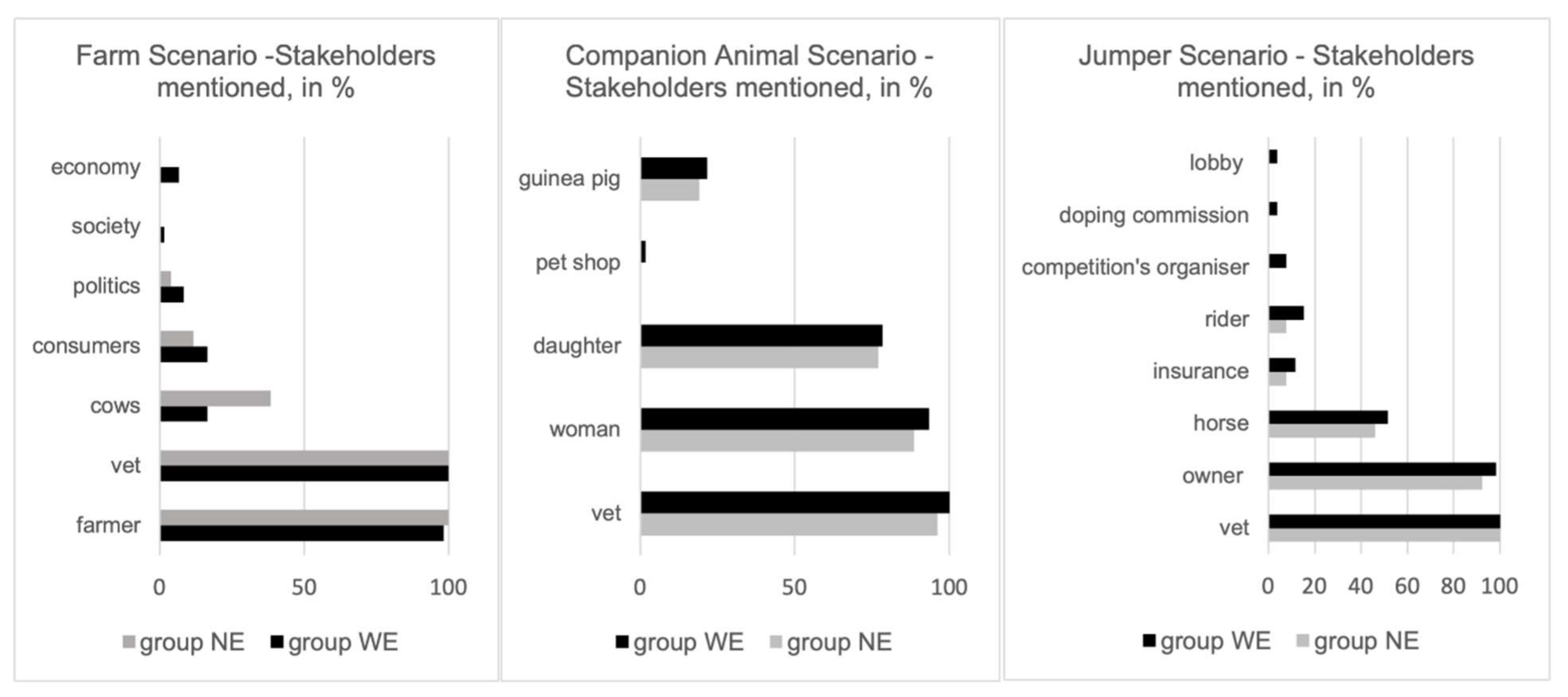
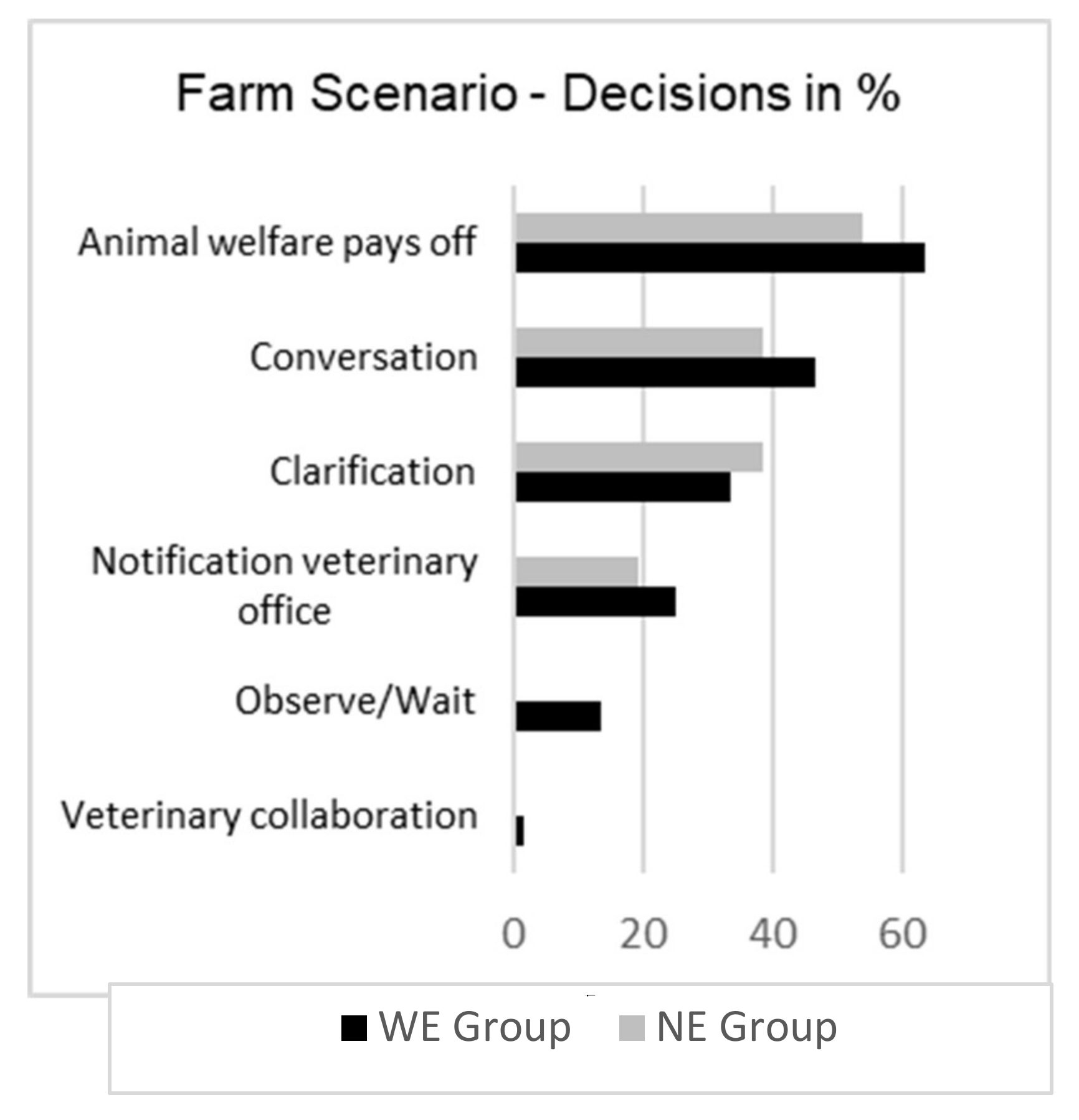
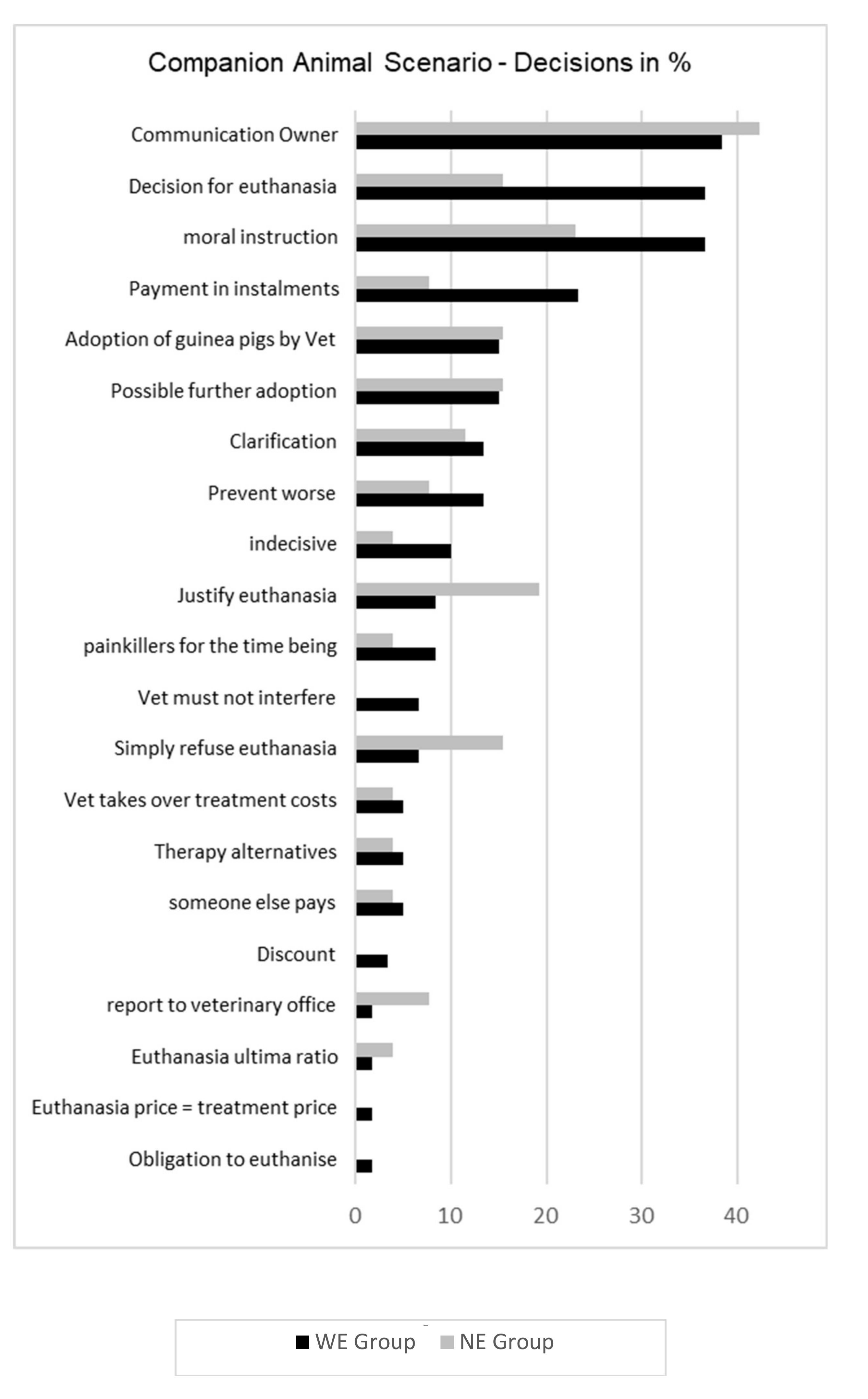
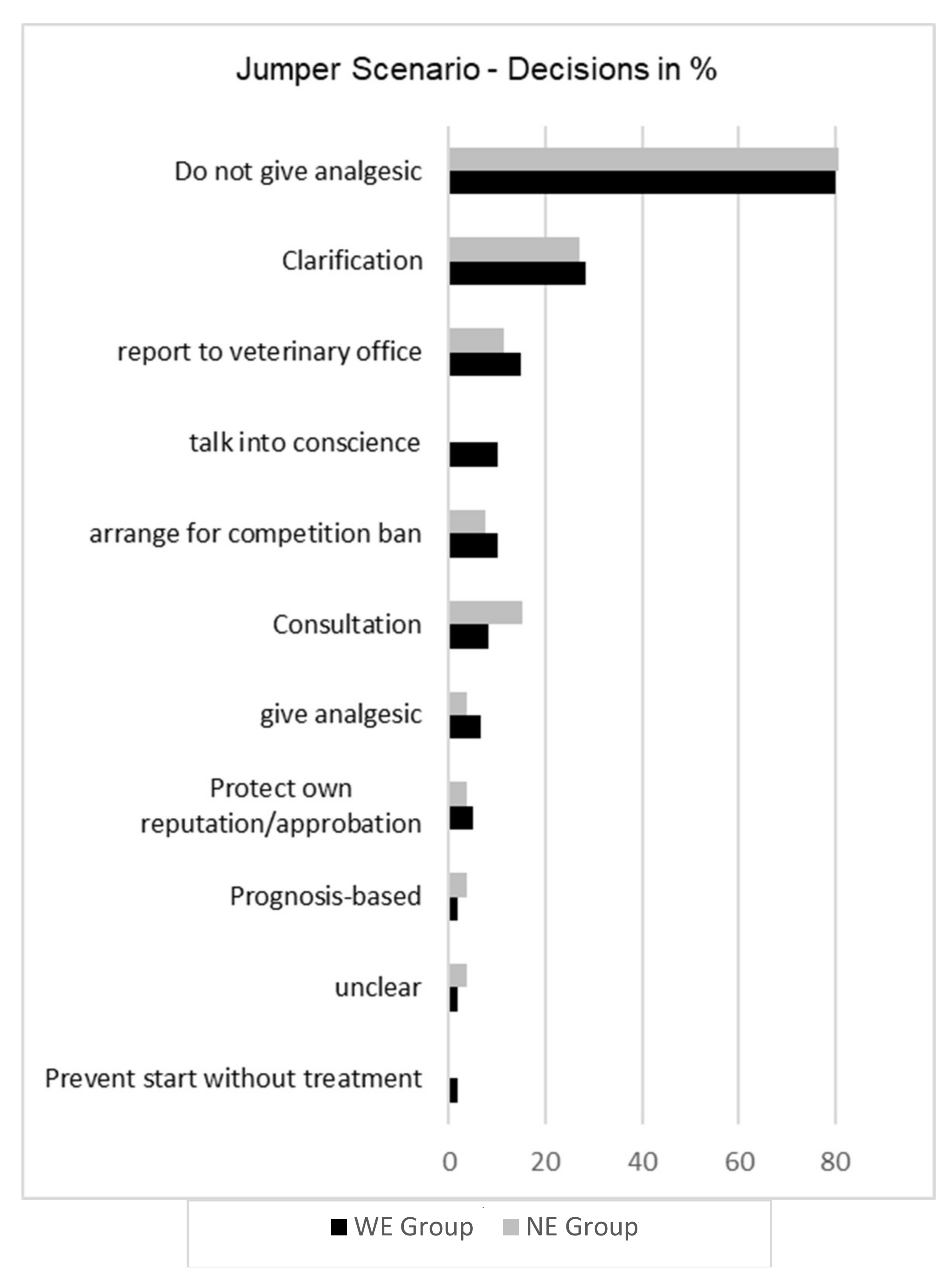
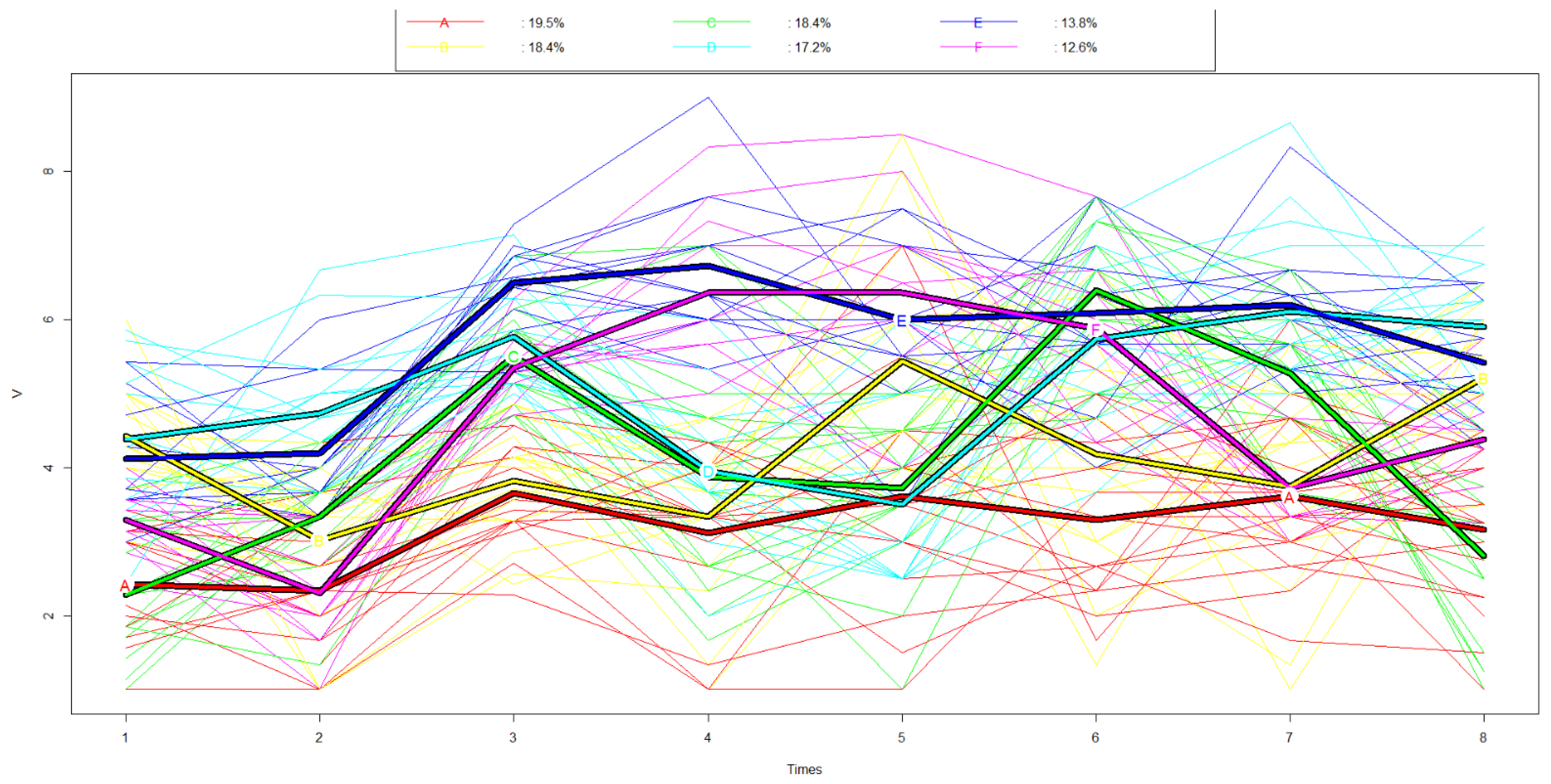
| Scenario | Statement |
|---|---|
| 1: Farm Scenario | S1. The motto is wait and see. Dr. Huf-Schmidt only treats one cow and takes a look at the other animals the day after next during the treatment check. |
| S2. Animal welfare should come first. Dr. Huf-Schmidt explains that the other cows also need treatment and that she will only treat the one cow if she is allowed to treat the others. | |
| S3. According to the [German] Animal Protection Act, it is forbidden to cause pain, suffering or harm to an animal without reasonable cause. Dr. Huf-Schmidt should explain this and threaten to file charges if the farmer continues to refuse treatment. | |
| S4. Informed decisions of patient owners should not be questioned. Dr. Huf-Schmidt therefore only treats the one cow. | |
| S5. The economic constraints must be taken into account. Dr. Huf-Schmidt therefore offers the farmer a “bulk discount” when treating the other cows. | |
| S6. The right communication is crucial. Dr. Huf-Schmidt explains in detail the arguments in favor of treating all animals, but gives in if the farmer does not agree after all, so as not to lose him as a customer. | |
| 2. Companion Animal Scenario | S7. The informed decision of the patient owner (PB) takes precedence. The veterinarian should comply with her wishes and euthanize the animal. |
| S8. The Animal Protection Act states that an animal owner must pay for the care of the animal. The veterinarian should inform the PB about her duties towards the animal and euthanize the animal only in case of subsequently ordered animal restraint. | |
| S9. The euthanasia demanded by the PO is not ethically justifiable-curative treatment without payment would not be economically justifiable. The veterinarian should refuse euthanasia and send the family away. | |
| S10. The welfare of the guinea pig comes first. The veterinarian should take the animal into care and treat it without charging the costs to the PO. Subsequently, it should be passed on via an animal welfare organization. | |
| S11. It should be possible to convince the PO with arguments. The vet should try with a conversation and only give in if she cannot be convinced. | |
| S12. All needs must be considered. The veterinarian should therefore explain to the daughter that he will exceptionally treat the guinea pig free of charge if the mother does not want to pay. | |
| 3. Jumper Scenario | S13. The informed decision lies with the PO. Dr. Knecht-Weber therefore complies with the request of the PO and administers the analgesic. |
| S14. The demand of the PO is ethically not justifiable. Dr. Knecht-Weber therefore refuses the requested analgesic without further discussion. | |
| S15. This can be clarified in a conversation with well-founded arguments. So Dr. Weber-Knecht tries to convince the owner of the treatment and the protection of the horse and gives the analgesic only if the PO really does not give in. | |
| S16. The PO’s (economic and prestige) interest in participating in the competition is understandable. Dr. Weber-Knecht agrees with the owner that this is a one-time exception for the important competition and administers the analgesic. | |
| S17. The measure demanded by the PO violates the animal welfare law. Dr. Knecht-Weber informs the owner about his duties towards the animal and threatens to report him to the responsible veterinary office if he allows the horse to start at the competition. |
| Statement | Without Ethics | With Ethics | Orientations | |
|---|---|---|---|---|
| Mean (SD) | Mean (SD) | Mean (SD) | ||
| S1 WaitAndSeeFarm | 5.78 (1.9) | 5.84 (1.9) | 5.75 (1.9) | O8 |
| S2 TreatAllFarm | 4.12 (2.3) | 3.72 (2.03) | 4.28 (2.4) | O3, O4, |
| S3 AnimalWelfareActFarm | 4.29 (2.4) | 4.52 (2.3) | 4.20 (2.4) | O7 |
| S4 ClientAutonomyFarm | 2.37 (1.9) | 2.48 (1.9) | 2.33 (1.9) | O1 |
| S5 DiscountFarm | 5.79 (2.4) | 5.72 (2.4) | 5.82 (2.4) | O2, O3, O5 |
| S6 CommunicationFarm | 5.45 (2.2) | 5.2 (2.2) | 5.56 (2.3) | O1, O6 |
| S7 ClientAutonomyCompanion | 3.28 (2.4) | 3.52 (2.6) | 3.18 (2.4) | O1 |
| S8 AnimalWelfareActCompanion | 4.27 (2.3) | 3.76 (2.2) | 4.48 (2.3) | O3, O7 |
| S9 SendClientAway | 3.42 (2.6) | 2.60 (2.1) | 3.75 (2.7) | O4, O8 |
| S10 TakeOverCompanion | 6.00 (2.3) | 5.56 (2.5) | 6.18 (2.2) | O3, O5 |
| S11 CommunicationCompanion | 5.92 (2.5) | 5.56 (2.8) | 6.06 (2.4) | O1, O6 |
| S12 FreeTreatmentCompanion | 2.49 (1.8) | 2.52 (1.6) | 2.48 (1.9) | O2, O3, O5, O6 |
| S13 ClientAutonomyJumper | 1.86 (1.5) | 1.68 (1.1) | 1.93 (1.7) | O1 |
| S14 RefusalJumper | 5.42 (2.8) | 5.16 (3.0) | 5.52 (2.7) | O3, O4, |
| S15 CommunicationJumper | 3.81 (2.3) | 3.48 (2.2) | 3.95 (2.4) | O1, O6 |
| S16 EconomyJumper | 1.70 (1.2) | 1.88 (1.2) | 1.62 (1.2) | O1, O2 |
| S17 AnimalWelfareActJumper | 6.89 (2.3) | 6.32 (2.3) | 7.11 (2.2) | O3, O7 |
| Total | Cluster A | Cluster B | Cluster C | Cluster D | Cluster E | Cluster F | |
|---|---|---|---|---|---|---|---|
| Mean (sd) | Mean (sd) | Mean (sd) | Mean (sd) | Mean (sd) | Mean (sd) | Mean (sd) | |
| O1 | 3.44 (1.22) | 2.42 (0.75) | 4.43 (0.68) | 2.28 (0.91) | 4.38 (1.03) | 4.12 (0.87) | 3.30 (0.45) |
| O2 | 3.31 (1.23) | 2.33 (0.90) | 3.02 (0.95) | 3.33 (0.75) | 4.73 (0.91) | 4.19 (0.87) | 2.3 (0.78) |
| O3 | 5.00 (1.22) | 3.65 (0.69) | 3.82 (0.77) | 5.51 (0.62) | 5.77 (0.69) | 6.50 (0.54) | 5.35 (0.41) |
| O4 | 4.35 (1.76) | 3.12 (1.06) | 3.33 (1.05) | 3.87 (1.58) | 3.95 (0.94) | 6.72 (1.00) | 6.36 (1.06) |
| O5 | 4.62 (1.71) | 3.62 (1.45) | 5.44 (1.49) | 3.72 (1.06) | 3.50 (1.10) | 6.00 (1.15) | 6.36 (1.43) |
| O6 | 5.16 (1.62) | 3.29 (1.07) | 4.19 (1.50) | 6.39 (0.95) | 5.73 (1.09) | 6.08 (1.10) | 5.88 (1.02) |
| O7 | 4.74 (1.51) | 3.61 (1.11) | 3.75 (1.30) | 5.27 (0.99) | 6.11 (1.07) | 6.19 (0.87) | 3.73 (0.77) |
| O8 | 4.41 (1.51) | 3.16 (1.07) | 5.22 (0.93) | 2.81 (1.18) | 5.90 (0.88) | 5.42 (0.76) | 4.39 (0.74) |
Publisher’s Note: MDPI stays neutral with regard to jurisdictional claims in published maps and institutional affiliations. |
© 2022 by the authors. Licensee MDPI, Basel, Switzerland. This article is an open access article distributed under the terms and conditions of the Creative Commons Attribution (CC BY) license (https://creativecommons.org/licenses/by/4.0/).
Share and Cite
Persson, K.; Gerdts, W.-R.; Hartnack, S.; Kunzmann, P. Assessing Moral Judgements in Veterinary Students: An Exploratory Mixed-Methods Study from Germany. Animals 2022, 12, 586. https://doi.org/10.3390/ani12050586
Persson K, Gerdts W-R, Hartnack S, Kunzmann P. Assessing Moral Judgements in Veterinary Students: An Exploratory Mixed-Methods Study from Germany. Animals. 2022; 12(5):586. https://doi.org/10.3390/ani12050586
Chicago/Turabian StylePersson, Kirsten, Wiebke-Rebekka Gerdts, Sonja Hartnack, and Peter Kunzmann. 2022. "Assessing Moral Judgements in Veterinary Students: An Exploratory Mixed-Methods Study from Germany" Animals 12, no. 5: 586. https://doi.org/10.3390/ani12050586
APA StylePersson, K., Gerdts, W.-R., Hartnack, S., & Kunzmann, P. (2022). Assessing Moral Judgements in Veterinary Students: An Exploratory Mixed-Methods Study from Germany. Animals, 12(5), 586. https://doi.org/10.3390/ani12050586






